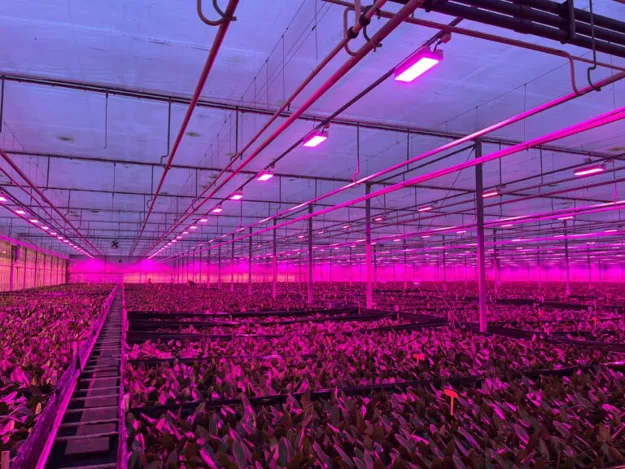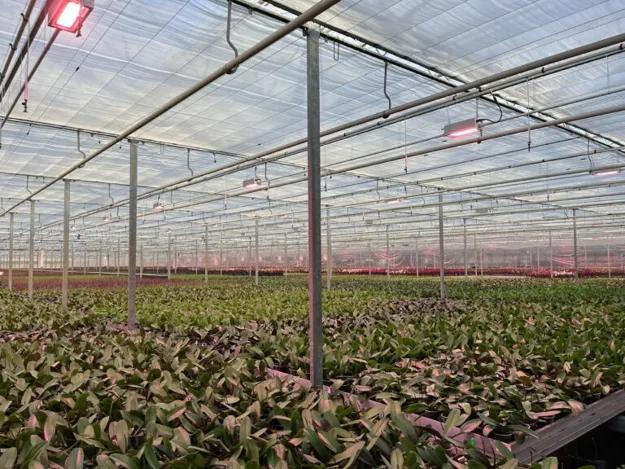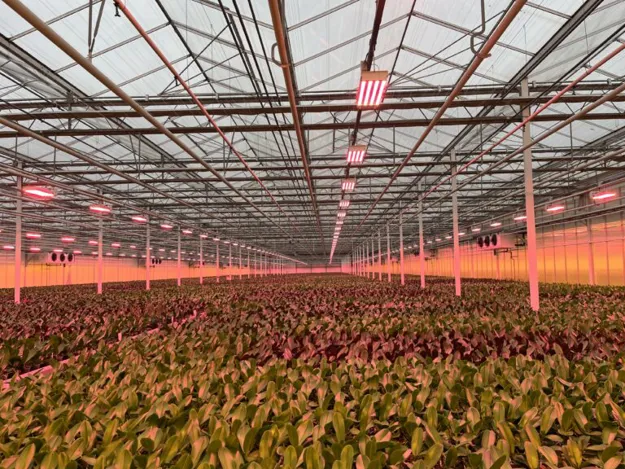Investing in LEDs means choosing which color spectrum to use. This was not easy. A year ago, the experience of growing Phalaenopsis under LEDs was still very minimal, and in terms of response to the spectrum, there was still very little information.
The most efficient spectrum contains as much red and as few other colors within the PAR spectrum as possible. In general, research has shown that a plant needs at least 5% blue light for proper growth. In addition, it is nice to have some white light to enhance plant visibility when scouting and working in the greenhouse, for example.
 LED luminaire of Mechatronix.
LED luminaire of Mechatronix.
White light is created by the white LEDs, which are actually blue LEDs with a phosphor coating. In the lighting recipe, white light is expressed as a percentage of green. White light actually contains the entire light spectrum, from red to a very small amount of far-red. When the lighting recipe refers to 5% green, the light fixture incorporates ±10% white LEDs.
On average, Dutch orchid growers use a hybrid system with a spectrum of 90% red, 5% green, and 5% blue. Only a few growers have added far-red (switchable). The benefit of far-red is not yet entirely clear; however, it does seem that adding far-red, particularly during the darkest time of the year (from mid-November to the end of January), improves leaf color: red-leaved varieties in particular, turn much redder under full LED without far-red. This red color is caused by anthocyanin, which is produced by the plant to protect itself from stress factors, in this case, light. In the finishing phase, far-red ensures faster flowering, but the difference with lighting without far-red is, at most, a few days, Plantlighting’s research has shown. In practice, it can be observed that with far-red, the branch length increases by several centimeters. It should be noted, however, that the differences between varieties are significant.
 Full LED red 95% – blue 5%.
Full LED red 95% – blue 5%.
As long as the lighting is carried out with LEDs in a hybrid system, it has been found that the light spectrum used is not that important. On the other hand, if a full LED system is used, the spectrum becomes much more important. A minimum of 5% green is necessary for good visibility in the greenhouse and in order to claim a subsidy.
 Hybrid LED in the cooling of Philips/Signify.
Hybrid LED in the cooling of Philips/Signify.
Heating and plant temperature
Lighting with LEDs implies lower energy input. If the light intensity is kept the same, the input is often around 50%. In addition, with LEDs, less energy is transferred from the lamps to the plants (only 80% compared to 90% with SON-T) because there is less radiant heat with LEDs. Supplementary heating is therefore necessary when using LEDs. Many growers have also made investments in new screens: a third screen and/or screens that offer much better energy savings. The screens are also opened less often to improve heat retention, so the additional expected energy demand through the boiler or CHP is quite small.
Lighting with LEDs also implies that plant temperature is a lot lower than in a situation with the same amount of PAR light with SON-T. An increase in premature flowering when using LEDs in the growing phase has not yet been observed, but this may also be due to more screening and less use of gaps with the energy screen to save gas.
 Full LED with water cooling (Oreon).
Full LED with water cooling (Oreon).
Lighting strategy
Start of the day: previous research has shown that when a Phalaenopsis is lit at a low intensity (up to 50 µmol/s/m²) for the first few hours of the light period, there is no less growth compared to when full-load (high intensity) lighting is used. This has also been used in practice for some time now. In most cases, Phalaenopsis growers with a hybrid LED installation cases started by turning on the SON-T as the first step and then switching on the LEDs. This activates the plants better than doing it the other way around.
An LED lamp can be switched on and off indefinitely without having to factor in a waiting period as is necessary with SON-T. This has great advantages for keeping the light intensity in the greenhouse as flat as possible. If daytime lighting is 100% switched on, it may be better to have the LEDs off and on. If the light requirement is lower, the SON-T can stay off and still be switched with the LED lighting.
 Full LED in the cooling phase (Dutch Lighting Innovations).
Full LED in the cooling phase (Dutch Lighting Innovations).
Aboveground and underground growth
Lighting with LEDs seems to cause a shift in plant development from aboveground to the underground. Lighting with LEDs seems to improve underground activity and, thus, growth and development, and aboveground plants grow a lot more compactly. Sometimes this can be due to increased light levels with LEDs compared to the old situation with SON-T, but this is certainly not often the case.
 LED of Hortilux in the finishing phase.
LED of Hortilux in the finishing phase.
Conclusion
In summary, growing Phalaenopsis under LEDs can be considered successful. It obviously requires some adjustments to the heating regime, especially on colder days. But because many growers have taken energy-saving measures, the extent to which extra heating needs to be added is quite insignificant.
For more information: Anthura
Anthura
www.anthura.nl
